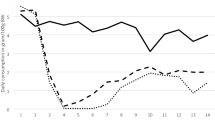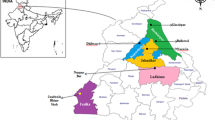Abstract
Maintaining the numbers of wood mice and common voles at an acceptable economic level, especially during years of massive outbreaks, is a major challenge in plant protection. Efforts to reduce the negative effects of rodenticides on the environment, to improve the integrated pest control system, and to minimize risks for human and animal health require investigation of the potentials of cellulose, as a natural product, and sodium selenite as rodenticides. The present study was conducted to determine the sensitivity of these rodent species to bromadiolone (a.i. 0.005 %), sodium selenite (a.i. 0.1 and 0.05 %), and cellulose (a.i. 45 %) baits. All experiments were done using no-choice and choice feeding trials. A low acceptance of cellulose baits was found in the choice feeding trial, and the time of first deaths indicate that stress and hunger increase the death rate in both species. The taste had a negative impact on the acceptability of baits containing sodium selenite. Low bait acceptance of cellulose and sodium selenite resulted in lower mortality of both species. The acquired results indicate that bromadiolone remains a more effective solution than cellulose and sodium selenite for control of wood mice and common voles.
Similar content being viewed by others
References
Anonymous (2007) Cellulose from powdered corn cobs. Health Canada Pest Management Regulatory Agency, Ottawa
Babinska-Werka J (1979) Effects of common vole on alfalfa crop. Acta Theriol 24:281–297
Daan S, Slopsema S (1978) Short-term rhythms in foraging behaviour of the common vole, Microtus arvalis. J Comp Physiol A 127:215–227
Dawson A, Garthwaite D (2001) Pesticide usage survey report 185-rodenticide usage by local authorities in Great Britain. DEFRA, New York
Eason CT, Henderson R, Murphy E, Shapiro L, MacMorran D, Blackie H, Brimble M, Conole D, Rennison D, Gibson TJ, Gregory NG (2011) Retrieving and retaining older and advancing novel rodenticides-as alternatives to anticoagulants. In: Jacob J, Esther A (eds) 8th Vertebrate pest management conference. Julius-Kühn-Archiv, vol 432, pp 19–20
Endepols S, Klemann N, Song Y, Kohn MH (2012) Vkorc1-Variation in house mouse during warfarin and difenacoum field trials. Pest Manag Sci 69:409–413
European Commission (2002) Guidance document on risk assessment for birds and mammals under council directive 91/414/EEC.SANCO/4145/2000. Directorate E: Food safety: plant health, animal health and welfare, international questions; E1: Plant health
Frenkel GD, Falvey D (1988) Evidence for the involvement of sulfhydryl compounds in the inhibition of cellular DNA synthesis by selenite. Mol Pharmacol 34:573–577
Frenkel GD, Falvey D (1989) Selenotrisulfide inhibits initiation by RNA polymerase II, but not elongation. J Inorg Biochem 35:179–189
Guidobono JS, León V, Gómez Villafañe IE, Busch M (2010) Bromadiolone susceptibility in wild and laboratory Mus musculus L. (house mouse) in Buenos Aires, Argentina. Pest Manag Sci 66:162–167
Henschler D, Kirschner U (1969) On the absorption and toxicity of selenium sulfide. Arch Toxikol 24:341–344
Heroldova M, Bryja J, Zejda J, Tkadlec E (2007) Structure and diversity of small mammal communities in agriculture landscape. Agr Ecosyst Environ 120:206–210
Heroldova M, Tkadlec E, Bryja J, Zejda J (2008) Wheat or barley? Feeding preferences affect distribution of three rodent species in agricultural landscape. Appl Anim Behav Sci 110:354–362
Hoogenboom I, Daan S, Dallinga JH, Schoenmakers M (1984) Seasonal change in the daily timing of behaviour of the common vole, Microtus arvalis. Oecologia 61:18–31
Jacevic VM, Milovanovic ZA, Jelic KA, Zolotarevski LD, Stankovic DA, Bokonjic DR, Milosavljevic IM (2006) Cardiotoxic effects of sodium selenite in rodents. Toxicol Lett 164:189
Jensen PS (1993) Temporal changes in food Preferences of wood mouse (Apodemus sylvaticus). Oecologia 94:76–82
Johnson RA, Prescott CV (1994) The laboratory evaluation of rodenticides. In: Buckle AP, Smith RH (eds) Rodent pests and their control. CAB International, Wallingford, pp 161–179
Jokić G, Vukša P, Vukša M (2010) Comparative efficacy of conventional and new rodenticides against Microtus arvalis (Pallas 1778) in wheat and alfalfa crops. Crop Prot 29:487–491
Kollmann J, Bassin S (2001) Effects of management on seed predation in wildflower strips in northern Switzerland. Agr Ecosyst Environ 83:285–296
Leung LKP, Seth S, Starr CR, El S, Russell IW, King CA, Vong TR, Chan P (2007) Selecting bait base to increase uptake of zinc phosphide and warfarin rodenticide baits. Crop Prot 26:1281–1286
Marsh RE (1988) Bait additives as a means of improving acceptance by rodents. Bull OEPP/EPPO 18:195–202
Mason G, Littin KE (2003) The humaneness of rodent pest control. Anim Welfare 12:1–37
OEPP/EPPO (2004) Laboratory tests for evaluation of the toxicity and acceptability of rodenticides and rodenticide preparations, PP 1/113 (2). In: EPPO Standards PP1. Efficacy evaluation of plant protection products miscellaneous, vol 5, 2nd edn. European and Mediterranean Plant Protection Organization, Paris, pp 23–35
Pelz HJ (1989) Ecological aspects of damage to sugar beet seeds by Apodemus sylvaticus. In: Putman RJ (ed) Mammals as pests. Chapman and Hall, London, pp 34–48
Pitt WC, Driscoll LC, Sugihara RT (2011) Efficacy of rodenticide baits for the control of three invasive rodent species in Hawaii. Arch Environ Contam Toxicol 60:533–542
Pletnikova IP (1970) Biological action and the non-injuriousness level of selenium when it enters the organism together with drinking water. Gig Sanit 35:14–19
Prakash S, Kumar S, Veer V, Gopalan N, Purnanand, Pandey KS, Rao KM (2003) Laboratory evaluation of four rodenticides admixed in a cereal-based bait against commensal rat, Rattus rattus (L) (Rodentia: Muridae: Murinae). J Stored Prod Res 39:141–147
Salmon TP, Dochtermann NA (2006) Rodenticide grain bait ingredient acceptance by Norway rats (Rattus norvegicus), California ground squirrels (Spermophilus beecheyi) and pocket gophers (Thomomys bottae). Pest Manag Sci 62:678–683
Saniga M (2003) Quantitative and qualitative damage caused by mammals and birds to the planting and natural seeding. J For Sci 49:37–43
Schmolz E (2010) Efficacy of anticoagulant-free alternative bait products against house mouse (Mus musculus) and brown rats (Rattus norvegicus). Integr Zool 5:44–52
Schmolz E (2011) Influence of bait type and active ingredient on rodenticide palatability and efficacy. In: Robinson WH, Eugênia de Carvalho Campos A (eds) 7th International Conference on Urban Pests. Instituto Biológico, São Paulo, pp 227–233
Sokal RR, Rohlf FJ (1995) Biometry. Freeman, New York
Tabara A, Yamane C, Seguchi M (2012) Low-calorie bread baked with charred cellulose granules and wheat flour to eliminate toxic xanthene food dye in the alimentary canal. Biosci Biotechnol Biochem 76:2173–2180
Acknowledgments
This research was financially supported by the Ministry of Education, Science and Technological Development of Republic of Serbia (Grants: III 46008).
Author information
Authors and Affiliations
Corresponding author
Additional information
Communicated by J. Jacob.
Rights and permissions
About this article
Cite this article
Jokić, G., Vukša, M., Đedović, S. et al. Laboratory testing of wood mouse and common vole sensitivity to bromadiolone, sodium selenite, and cellulose. J Pest Sci 87, 309–314 (2014). https://doi.org/10.1007/s10340-014-0554-x
Received:
Accepted:
Published:
Issue Date:
DOI: https://doi.org/10.1007/s10340-014-0554-x




